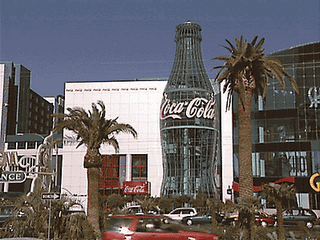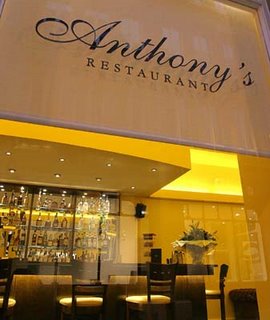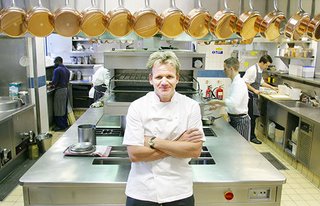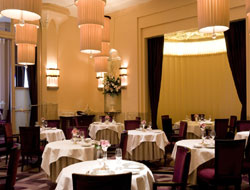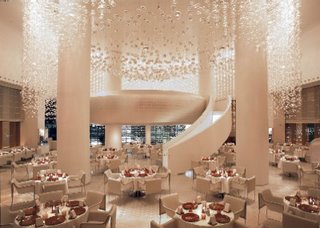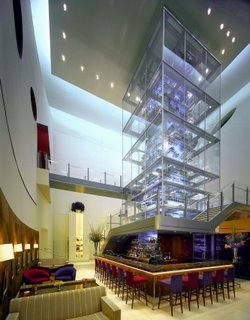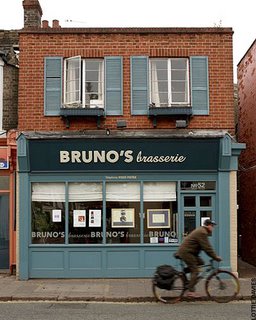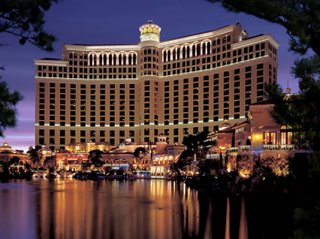 I am a sap. An uncultivated one, at that. Our last day in Las Vegas saw me standing outside Bellagio and bawling my eyes out when the fountains danced in the sun to the Star Spangled Banner, making rainbows appear in the spray.
I am a sap. An uncultivated one, at that. Our last day in Las Vegas saw me standing outside Bellagio and bawling my eyes out when the fountains danced in the sun to the Star Spangled Banner, making rainbows appear in the spray.
God Save the Queen has never had this effect on me.
Bellagio is one of my very favourite casinos in Las Vegas. Dr W finds it a bit too busy, especially at night, so we stay at the quieter Mandalay Bay, but we do a lot of our eating at Bellagio. A foodie could easily stay at Bellagio for a week and not feel any need to step outside the building. Both Le Cirque and Picasso have four AAA diamonds; Jasmine is one of Vegas’s top Chinese restaurants (charmingly, all the dishes at Jasmine are priced at some dollars and 88 cents, 88 being an extremely auspicious number which represents long life and prosperity). Prime is an exceptional steakhouse; Jean Phillipe kicked off the new Vegas vogue for fabulous French pastries and houses the world’s largest chocolate fountain. There are another five or so classy restaurants I’ve not tried; all this on top of one of the city’s very best buffets; Petrossian, which offers caviar and high tea; and a few more casual cafés.
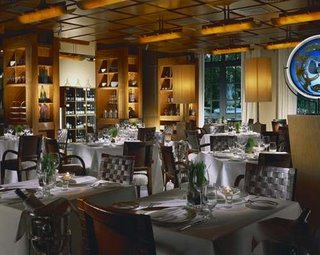 Michael Mina is Chef Mina’s flagship restaurant in a city where he runs four of the things. I have no idea how he manages to assure quality across all of his restaurants, but he works it all with some style – no trip to Vegas is complete for me without at least one visit to his Stripsteak (Mandalay Bay); and his two MGM Grand outposts (Seablue and Nob Hill) attract stellar reviews.
Michael Mina is Chef Mina’s flagship restaurant in a city where he runs four of the things. I have no idea how he manages to assure quality across all of his restaurants, but he works it all with some style – no trip to Vegas is complete for me without at least one visit to his Stripsteak (Mandalay Bay); and his two MGM Grand outposts (Seablue and Nob Hill) attract stellar reviews.
I was looking for somewhere really special where we could eat our Christmas meal – although Vegas largely ignores the holiday, some restaurants (Picasso among them) close their doors for Christmas day, so booking can be a little complicated. Happily, Michael Mina was taking reservations. I’ll admit to a little trepidation – would service and cooking be as good as usual on Christmas Day, when people would rather be with their families? As it turned out, the answer was a very delicious yes. We both selected the Cookbook Tasting Menu, made up of recipes from Michael Mina: The Cookbook(full of things you’re unlikely to cook at home because black cod, small and succulent lobsters, fresh truffles, raw quail eggs, fresh foie gras and Kobe beef are probably not available at your local corner shop). An additional $35 will also secure you a signed copy of the book. I turned the offer down; near my baggage limit already, I couldn’t afford the extra weight (and I’m cheap). Although Mina’s particular speciality is fish, there is plenty of meat available on the tasting menus (three tasting menus were on offer on the day we visited, one vegetarian) and on the a la carte menu.
The day’s amuse bouche was a carrot and curry soup – simple but very delicious. Michael Mina’s breads are always a work of art, and the Agen prune and black pepper buns were yeasty little joys.
The menu proper opens with one of Mina’s signature dishes, tuna tartar, which is mixed at the table, requiring two servers. Tiny dice of garlic, jalapeño and apple were mixed into the exceptionally fresh tuna, with the yolk of a quail egg, apple, mint chiffonade and pine nuts.
As usual, I had to ask for a non-lobster alternative for the lobster course. (Anaphylaxis is always embarrassing in public.) Our server, who was so helpful throughout the meal that I wanted to take him home with me and give him the vacuum cleaner, suggested swapping it out for any course from the other tasting menu. This is always an excellent sign in a restaurant (some places will just give you a grudging bowl of the soup of the day, which is utterly depressing when your dining partner is chomping through a perfect hunk of truffled claw-meat). The lobster pot pie is one of Mina’s signature dishes, and Dr W holds that it’s the best lobster dish he’s ever tried. The pastry lid is scored and lifted off for you at the table, and I can tell you it smells about as good as Dr W says it tastes. My substitute course was a crisp-skinned black sea bass with scallop tempura in a red wine jus with cauliflower purée and wild mushrooms. The myriad different but complementary things going on in this dish were pure Mina – and the scallop, barely cooked but crisply enrobed in tempura, was uniquely sweet and delicate.
My favourite course was the black cod in miso (sadly a million times more delicate than my own pretty darn good miso-glazed salmon, which is why Michael Mina is a millionaire chef who owns 11 restaurants and I am only a moderately successful food blogger). This is another Mina million-things-at-once dish; it came with enoki, shitake and something my notebook claims as ‘mystery mushroom’, a soft ravioli (raviolus?) filled with a Chinese shrimp and scallop mixture, all sat in a dark and savoury mushroom consommé on a bed of pak choi.
Rib-eye Rossini was up next. Rib eye is, apparently, Mina’s favourite cut of steak. It’s tender but comes from an area close to the bone; a good piece is gorgeously marbled and has all the flavour that comes from the proximity of that bone. The foie gras on top was seared to perfection. (Fans of this preparation will either be amused or horrified to learn that elsewhere in the city, at Hubert Keller’s Burger Bar and Fleur de Lys, you can order a Kobe Rossini burger, prepared with truffles, dark red wine and shallot jus, and foie gras, approximately like a steak Rossini, for $60. I have never sampled it – Kobe’s too soft to make a decent burger from and anyway, the whole thing sounds like a postmodern Las Vegas step too far for me.)
A trio of Mina’s signature desserts featured the menu’s only nod to that Las Vegas postmoderism – a root beer float. Dr W doesn’t like root beer, but he slurped this down like a baby craving mother’s milk. Fizzy, icy mother’s milk. Three of the best chocolate and pecan cookies to pass your lips also nestle on the plate, next to a chocolate fondant so good that the sale of someone’s soul must have been involved somewhere.
An interesting conversation went on at the table next to us. The lady there told her waiter she’d not found a good cof
fee yet in Las Vegas (I would have pointed her at Bouchon or Jean Philippe). Her waiter said that this has much to do with the city’s awful tap water – tap water that is so chlorinated and oddly sweet that I find it hard to drink. He talked about the new espresso machine in the restaurant, the filtered water and the special blend and roast, and told her that if she didn’t like her coffee it would be on the house.
When she had finished her first espresso, she ordered another double.
So we, of course, ordered coffees, and they were excellent. The petits fours were a real treat – I much prefer an old-fashioned sampling of petits fours to the boring plate of posh chocolates that so many restaurants seem to be offering these days.
So then. How do I top this next Christmas?

